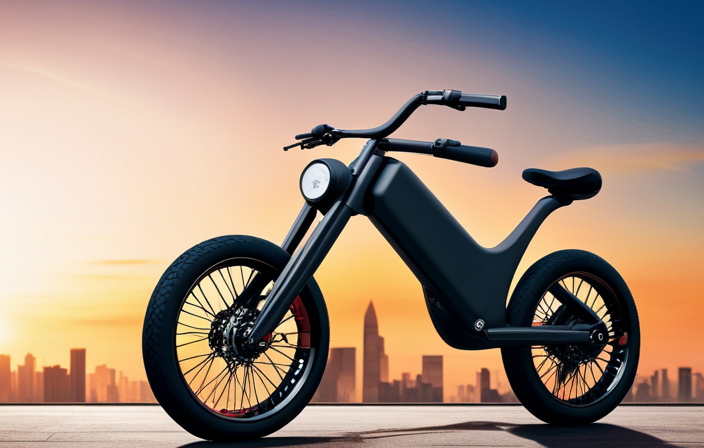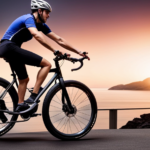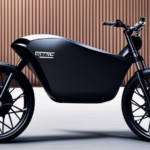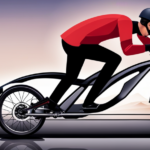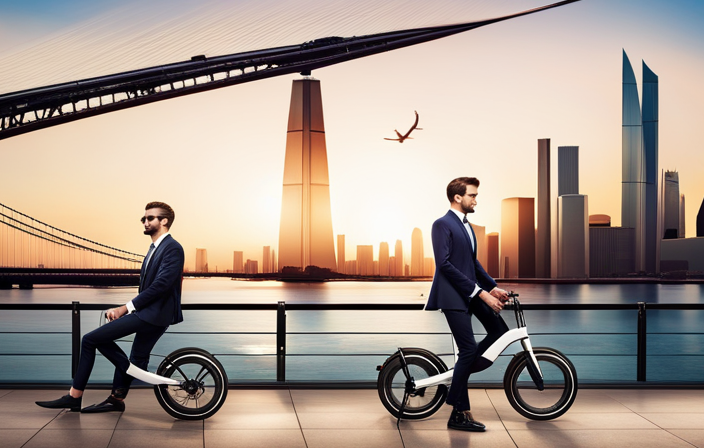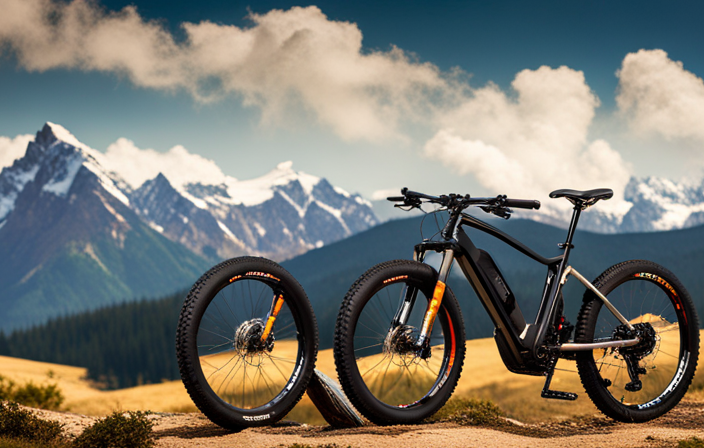Pedaling an electric bike may seem like a perplexing puzzle, but fear not, as I am here to unravel the mystery.
In this article, we will delve into the depths of electric bike mechanics to understand just how hard you need to push those pedals.
From exploring pedal assist levels to mastering efficient pedaling techniques, we will uncover the secrets to maximizing your electric bike experience.
So, hop on, buckle up, and prepare for a ride filled with electrifying enlightenment.
Key Takeaways
- Pedaling conserves energy and increases efficiency.
- Understanding pedal assist levels helps maximize distance on a single charge.
- Maintain a consistent cadence for efficient pedaling.
- Strike a balance between pedaling effort and electric assistance.
Understanding the Basics of Electric Bikes
To understand the basics of electric bikes, you need to know how hard you have to pedal. Electric bikes are designed to assist your pedaling effort, making it easier to ride longer distances and tackle inclines. The level of pedal assistance can be adjusted based on your preference and the terrain you are riding on.
When it comes to electric bike maintenance, it is important to keep the battery charged and ensure that the motor is functioning properly. Choosing the right electric bike for your needs is crucial, taking into consideration factors such as motor power, battery range, and overall comfort.
Now, let’s delve into how electric bikes work and the technology behind their operation.
How Electric Bikes Work
Understanding the mechanics of an e-bike can help you grasp how they function. Electric bikes work by combining human power with electric assistance, making them a popular choice for those looking for an eco-friendly and efficient mode of transportation.
Electric bike technology has evolved over the years, with advancements in battery capacity and motor power output. The power output of electric bikes is measured in watts, with higher wattage resulting in more assistance provided by the motor. Modern e-bikes typically have motors with power outputs ranging from 250 to 750 watts.
This power output determines how hard you have to pedal an electric bike. Higher wattage motors require less effort from the rider, while lower wattage motors require more pedaling input. Understanding the power output of an electric bike is essential for finding the right pedal assist level.
Finding the Right Pedal Assist Level
Finding the right pedal assist level on an e-bike is crucial for a comfortable and efficient ride. It allows the rider to find the optimal balance between their own pedaling effort and the assistance provided by the electric motor.
Adjusting the pedal resistance can help achieve this balance. Most e-bikes offer different levels of pedal assist, which can be adjusted according to the rider’s preference and the terrain they are riding on.
A lower assist level requires more pedaling effort from the rider, making it suitable for flat or downhill sections. On the other hand, a higher assist level provides more assistance from the motor, making it easier to climb hills or ride against strong headwinds.
Finding the optimal pedal assist level ensures that the rider can maintain a comfortable pace without exerting too much effort. With the right pedal assist level set, it’s time to explore adjusting your pedaling technique for an even smoother ride.
Adjusting Your Pedaling Technique
Now let’s focus on how to fine-tune your pedaling technique for a smoother ride.
Adjusting your pedaling technique is crucial for improving efficiency and preventing muscle fatigue when riding an electric bike.
To maximize your performance, start by maintaining a consistent cadence throughout your ride. This means avoiding sudden bursts of speed or slowing down abruptly.
Additionally, try to distribute your pedaling force evenly throughout the entire pedal stroke. This can be achieved by pushing down on the pedal with your dominant leg while simultaneously pulling up with your other leg. By doing so, you engage more muscles and reduce strain on individual muscle groups.
Finally, pay attention to your posture and body alignment. Keeping your back straight and your core engaged will help you pedal with better control and stability.
Mastering these adjustments in your pedaling technique will enhance your overall riding experience and set the stage for discussing the benefits of pedaling on an electric bike.
The Benefits of Pedaling on an Electric Bike
When it comes to the benefits of pedaling on an electric bike, there are two key points to consider: exercise and fitness benefits, and extending battery life.
Pedaling on an electric bike allows me to engage in physical activity and get a good workout, helping me improve my cardiovascular health and strengthen my muscles.
Additionally, by pedaling on an electric bike, I am able to conserve the battery power and extend its life, allowing me to ride longer distances without worrying about running out of battery.
Exercise and Fitness Benefits
One of the key benefits of riding an electric bike is that you can still get a good workout without having to pedal as hard. The electric motor assists you in pedaling, reducing the amount of effort required. However, this doesn’t mean that you won’t be able to burn calories or increase your exercise intensity. In fact, studies have shown that riding an electric bike can still provide a moderate level of exercise and calorie burning.
To illustrate this, let’s take a look at the following table:
| Speed (mph) | Pedaling Effort | Calorie Burning (per hour) |
|---|---|---|
| 10 | Low | 240 |
| 15 | Moderate | 360 |
| 20 | High | 480 |
| 25 | Very High | 600 |
| 30 | Maximum | 720 |
As you can see, even at lower speeds and with less pedaling effort, riding an electric bike can still result in significant calorie burning. This makes it a great option for individuals who want to improve their fitness level or lose weight.
Transitioning into the subsequent section about extending battery life, it’s important to note that finding the right balance between pedaling and using the electric motor can help conserve energy and make your battery last longer.
Extending Battery Life
To extend your battery life, it’s important to find the right balance between using the motor and pedaling on your e-bike. By conserving power, you can ensure that your battery lasts longer and you can enjoy a longer ride.
One way to extend battery life is by utilizing the different levels of assistance provided by the motor. For example, using a lower assistance level when riding on flat terrain or when you have a strong tailwind can help conserve power.
Additionally, pedaling along with the motor can reduce the load on the motor and decrease power consumption. Another technique is to anticipate obstacles or inclines and pedal harder before reaching them, so you rely less on the motor.
This strategic approach to pedaling can help maximize your battery life and ensure a more enjoyable ride.
Knowing When to Pedal Harder
You need to pedal harder on an electric bike to generate more power. Knowing when to push harder is essential to avoid pedal resistance and maximize your riding experience. By understanding the electric bike’s power delivery system, you can optimize your pedaling effort. When riding at lower assist levels, such as Eco or Tour, you may need to pedal harder to maintain a comfortable speed. On the other hand, when riding at higher assist levels, like Sport or Turbo, you can pedal with less effort as the motor provides significant assistance. It is important to find the right balance between pedaling and motor assistance to ensure efficient power usage and extend your battery’s range. In the next section, we will explore how pedaling affects your range without compromising performance.
How Pedaling Affects Your Range
When it comes to electric bikes, understanding how pedaling affects your range is crucial.
Two key points to consider are battery life and efficiency, as well as maximizing the distance you can travel on a single charge.
By pedaling, you can extend the battery life of your electric bike, as the motor doesn’t have to work as hard.
Additionally, by finding the right balance between pedaling and motor assistance, you can maximize the distance you can travel on a single charge, making your electric bike even more efficient.
Battery Life and Efficiency
Though the battery life of an electric bike can vary, you’ll find that pedaling will help to conserve energy and increase efficiency.
When it comes to battery charging methods, it’s important to follow the manufacturer’s guidelines to ensure optimal performance. Charging the battery fully before each ride will maximize its lifespan and range.
Additionally, the terrain you ride on can also impact battery life. Uphill climbs and rough terrains require more power, draining the battery faster. On the other hand, riding on flat surfaces or downhill can help conserve battery life.
By pedaling while using the electric assist, you can further extend the range of your electric bike. This combination of pedaling and electric power allows you to maximize distance on a single charge, making your ride more efficient and enjoyable.
Maximizing Distance on a Single Charge
To maximize the distance you can travel on a single charge, it is important to consider the terrain and pedal in conjunction with the electric assist feature. By optimizing pedal assist power, you can increase your battery longevity and get the most out of your electric bike. To help you understand how to achieve this, I have created a table below that outlines different pedal assist levels and their corresponding power output.
| Pedal Assist Level | Power Output |
|---|---|
| Level 1 | 50% |
| Level 2 | 75% |
| Level 3 | 100% |
By selecting a lower pedal assist level on flat terrain or when going downhill, you can conserve battery power and extend your range. However, on uphill sections or when you need an extra boost, you can increase the pedal assist level accordingly. By understanding these levels and optimizing your pedal assist power, you can maximize your distance on a single charge. In the next section, I will provide some tips for efficient pedaling on an electric bike without compromising your battery life.
Tips for Efficient Pedaling on an Electric Bike
For efficient pedaling on an electric bike, it’s important to maintain a consistent cadence. Efficient pedaling techniques involve finding the right balance between the assistance provided by the electric motor and the power generated by your own legs.
One key aspect is maintaining a consistent pedaling speed throughout your ride. This helps optimize the assistance from the electric motor and ensures a smooth and efficient cycling experience. By keeping a steady cadence, you can better control the power output and energy consumption of your electric bike.
Additionally, it minimizes the strain on your muscles and reduces the risk of fatigue. Understanding the limits of electric bike assistance will be discussed further, allowing you to make the most out of your electric bike experience.
Understanding the Limits of Electric Bike Assistance
Understanding the limits of e-bike assistance helps optimize your cycling experience. It is important to be aware of the pedal assistance limitations in order to make the most of your ride. Here are some key points to consider:
-
Power output: Electric bikes have a maximum power output, usually measured in watts. This means that the motor can only provide a certain amount of assistance to your pedaling.
-
Speed limit: Most electric bikes have a speed limit, beyond which the motor will stop providing assistance. This is typically around 20 mph, but it can vary depending on the specific model.
-
Battery life: The amount of assistance you receive also depends on the battery life. As the battery depletes, the power output may decrease, affecting the level of assistance you receive.
Understanding these limitations allows you to optimize your pedal power and make the most of your electric bike. By finding the right balance between pedaling and electric assistance, you can enjoy a smooth and efficient ride.
Enjoying the Ride with the Right Balance of Pedaling and Electric Assistance
In the previous subtopic, I discussed the limits of electric bike assistance and how it affects your overall riding experience.
Now, let’s delve into the importance of finding the right balance between pedaling and electric assistance to fully enjoy your ride.
When riding an electric bike, it’s crucial to strike a balance between your own effort and the assistance provided by the motor. By maintaining a constant pedaling motion, you can effectively balance the effort required from your legs and the power delivered by the motor. This not only helps you conserve battery life but also ensures a smooth and enjoyable ride.
Furthermore, finding the right balance of pedaling and electric assistance allows you to maintain a consistent speed. By adjusting the level of assistance based on your riding conditions and terrain, you can effortlessly tackle uphill climbs or breeze through flat surfaces without exerting excessive effort.
In conclusion, balancing effort and maintaining speed is key to maximizing the benefits of an electric bike and enhancing your overall riding experience.
Frequently Asked Questions
Can I ride an electric bike without pedaling at all?
No, you cannot ride an electric bike without pedaling at all. Electric bikes have speed limits and pedaling helps to maximize their efficiency and range. Pedaling also provides health benefits and allows for a more enjoyable riding experience.
How does the weight of the rider affect the amount of pedaling required on an electric bike?
The weight of the rider can affect the amount of pedaling required on an electric bike. Heavier riders may need to pedal more to achieve optimal performance and efficiency. Using proper pedaling techniques can maximize the bike’s performance.
Are there any specific techniques or strategies for pedaling on an electric bike?
To optimize battery power on an electric bike, specific pedaling techniques can be employed. By using a combination of smooth and steady pedaling, along with occasional bursts of energy, the rider can maximize efficiency and extend the battery life.
Does pedaling on an electric bike help to conserve battery power?
Pedaling on an electric bike is highly effective in conserving battery power. The level of assistance provided by the motor can be adjusted, and pedaling on flat terrain or downhill can even recharge the battery. However, uphill terrain requires more battery power.
Is there a maximum speed at which pedaling becomes ineffective on an electric bike?
Pedaling effectiveness on an electric bike decreases after reaching the maximum speed. At higher speeds, the motor takes over most of the work, making pedaling less effective.
Conclusion
In conclusion, pedaling an electric bike requires effort, but it is not as strenuous as riding a traditional bicycle. The level of pedal assist can be adjusted to suit your preference and riding conditions, allowing you to find the right balance between manual pedaling and electric assistance.
By adjusting your pedaling technique and finding the optimal pedal assist level, you can maximize the efficiency of your ride and extend your range. Remember, it’s all about finding the sweet spot where you can enjoy the ride with the wind in your hair and a smile on your face.
After all, as the saying goes, "No pain, no gain!"

